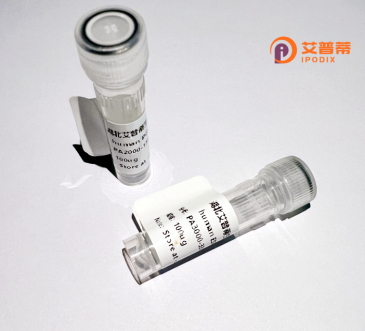
| 纯度 | >90%SDS-PAGE. |
| 种属 | Human |
| 靶点 | AGPS |
| Uniprot No | O00116 |
| 内毒素 | < 0.01EU/μg |
| 表达宿主 | E.coli |
| 表达区间 | 59-658aa |
| 氨基酸序列 | KA RRAASAATAA PTATPAAQES GTIPKKRQEV MKWNGWGYND SKFIFNKKGQ IELTGKRYPL SGMGLPTFKE WIQNTLGVNV EHKTTSKASL NPSDTPPSVV NEDFLHDLKE TNISYSQEAD DRVFRAHGHC LHEIFLLREG MFERIPDIVL WPTCHDDVVK IVNLACKYNL CIIPIGGGTS VSYGLMCPAD ETRTIISLDT SQMNRILWVD ENNLTAHVEA GITGQELERQ LKESGYCTGH EPDSLEFSTV GGWVSTRASG MKKNIYGNIE DLVVHIKMVT PRGIIEKSCQ GPRMSTGPDI HHFIMGSEGT LGVITEATIK IRPVPEYQKY GSVAFPNFEQ GVACLREIAK QRCAPASIRL MDNKQFQFGH ALKPQVSSIF TSFLDGLKKF YITKFKGFDP NQLSVATLLF EGDREKVLQH EKQVYDIAAK FGGLAAGEDN GQRGYLLTYV IAYIRDLALE YYVLGESFET SAPWDRVVDL CRNVKERITR ECKEKGVQFA PFSTCRVTQT YDAGACIYFY FAFNYRGISD PLTVFEQTEA AAREEILANG GSLSHHHGVG KLRKQWLKES ISDVGFGMLK SVKEYVDPNN IFGNRNLL |
| 分子量 | 72.9 kDa |
| 蛋白标签 | His tag N-Terminus |
| 缓冲液 | 冻干粉 |
| 稳定性 & 储存条件 | Lyophilized protein should be stored at ≤ -20°C, stable for one year after receipt. Reconstituted protein solution can be stored at 2-8°C for 2-7 days. Aliquots of reconstituted samples are stable at ≤ -20°C for 3 months. |
| 复溶 | Always centrifuge tubes before opening.Do not mix by vortex or pipetting. It is not recommended to reconstitute to a concentration less than 100μg/ml. Dissolve the lyophilized protein in distilled water. Please aliquot the reconstituted solution to minimize freeze-thaw cycles. |
以下是3-4篇关于重组人过氧化物酶体酶烷基甘油磷酸合酶(AGPS)的参考文献摘要:
1. **文献名称**:*Alkylglycerone phosphate synthase (AGPS) regulates lipid metabolism and ether lipid pathway in cancer*
**作者**:Benjamin et al. (2013)
**摘要**:研究了AGPS在癌症细胞中的功能,发现其通过调控醚脂质合成通路影响肿瘤生长和侵袭性,重组AGPS的表达可增强癌细胞对脂质代谢的依赖性。
2. **文献名称**:*Expression and characterization of recombinant human alkylglycerone phosphate synthase in E. coli*
**作者**:Ofman et al. (2006)
**摘要**:首次报道利用大肠杆菌系统重组表达人源AGPS,优化纯化方法并验证其酶活性,发现其以二聚体形式行使功能,为酶学研究提供基础工具。
3. **文献名称**:*Deficiency of alkylglycerone phosphate synthase causes peroxisomal dysfunction and rhizomelic chondrodysplasia punctata*
**作者**:Honsho et al. (2017)
**摘要**:通过疾病模型分析发现AGPS基因缺陷导致过氧化物酶体功能异常,与先天性点状软骨发育不良(RCDP)相关,揭示其在醚磷脂生物合成中的关键作用。
4. **文献名称**:*Crystal structure of human AGPS reveals catalytic mechanism and substrate specificity*
**作者**:Wang et al. (2020)
**摘要**:解析了人源AGPS的晶体结构,阐明其催化机制及底物结合位点,为针对癌症或代谢疾病的药物设计提供了结构基础。
*注*:以上信息为简化示例,实际文献需根据PMID或DOI检索原文核对。
Alkylglycerol phosphate synthase (AGPS) is a key enzyme localized in peroxisomes, membrane-bound organelles critical for lipid metabolism, reactive oxygen species detoxification, and biosynthesis of ether phospholipids. AGPS catalyzes the conversion of alkyl-dihydroxyacetone phosphate (alkyl-DHAP) to lyso-alkyl-phosphatidic acid, a rate-limiting step in plasmalogen synthesis. Plasmalogens, a subclass of ether phospholipids, are essential components of cellular membranes, particularly in nervous tissues, heart, and immune cells, where they contribute to membrane fluidity, signaling, and antioxidant defense. Their deficiency is linked to severe peroxisomal disorders, such as rhizomelic chondrodysplasia punctata type 3 (RCDP3), characterized by skeletal abnormalities, cataracts, and neurological impairments.
AGPS dysfunction disrupts ether lipid homeostasis, impacting organ development and cellular resilience. Recombinant human AGPS (rhAGPS), produced through heterologous expression systems (e.g., E. coli or mammalian cells), enables biochemical and structural studies to elucidate its catalytic mechanism and interaction with peroxisomal transporters. Its recombinant form is pivotal for functional assays, drug screening, and gene therapy research targeting peroxisomal diseases. Recent advances in cryo-EM and protein engineering have enhanced understanding of AGPS's dimeric structure and active-site dynamics, offering avenues to modulate its activity. As plasmalogens gain attention in neurodegenerative diseases (e.g., Alzheimer's) and metabolic syndromes, rhAGPS remains a vital tool for exploring therapeutic interventions and diagnostic biomarkers.
×